PITTSFIELDMASSACHUSETTS |
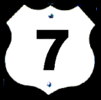 |
PITTSFIELDMASSACHUSETTS |
 |
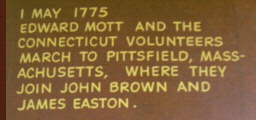 |
ETHAN ALLEN'S ROUTE TO Marker from |
"One thing I must mention to be kept as profound secret — the fort at Ticonderoga must be seized as soon as possible should hostilities be committed by the King's Troops. The people of New Hampshire Grants [Vermont] have engaged to do this business and in my opinion, they are the most proper persons for the job,"
— American Agent John Brown, March 29, 1775.
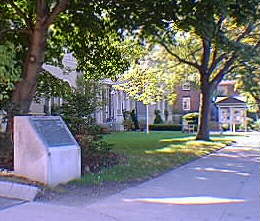 On May 1,
1775, John Brown, Captain Edward Mott and Colonel James Easton met here at
Easton's tavern to make initial plans to seize badly needed artillery and
munitions from the British at Fort Ticonderoga for the defense of Boston. This
was the first time Americans were considering an offensive military action
against the British. Prior to this time, Americans had either defended against
offensive actions, such as Lexington and Concord, or responded by organizing
demonstrations, such as the Boston Tea Party.
On May 1,
1775, John Brown, Captain Edward Mott and Colonel James Easton met here at
Easton's tavern to make initial plans to seize badly needed artillery and
munitions from the British at Fort Ticonderoga for the defense of Boston. This
was the first time Americans were considering an offensive military action
against the British. Prior to this time, Americans had either defended against
offensive actions, such as Lexington and Concord, or responded by organizing
demonstrations, such as the Boston Tea Party.
At the time of the meeting at Easton's Tavern, the patriot forces consisted of:
Their plan was to recruit additional men from the local Berkshire area and join forces with Colonel Ethan Allen and the Green Mountain Boys from Vermont.
The place where the meeting took place is marked in downtown Pittsfield between Park Square and the Berkshire Museum on the east side of US Route 7 (South Street). There is a stone marker where the meeting took place.
|
|
EASTON'S Near this spot stood Easton's Tavern. Here on May 1, 1775, Colonel James Easton and John Brown of Pittsfield and Captain Edward Mott of Preston, Connecticut planned the capture of Fort Ticonderoga which on May 10th surrendered to the Continental Volunteers under Ethan Allen with Colonel Easton second in command. |
A little over two years after this meeting (August 14, 1777),
word reached Pittsfield that British forces were advancing to seize Bennington's
storehouses. A rally was held at the meeting house (not far from today's South
Congregational Church) and troops 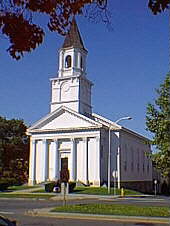 were mustered. A company under the leadership
of Captain William Ford included William Easton and the "Fighting
Parson," Thomas Allen. A regiment under the leadership of Colonel Simonds
and a detachment under the command of Lieutenant-Colonel David Rossiter of
Richmond completed the forces. After a powerful address by Parson Allen, they
left in haste for Bennington. An observer noted that the Parson chose to march
to Bennington in his sulky, "wisely conserving his forces for
combat."
were mustered. A company under the leadership
of Captain William Ford included William Easton and the "Fighting
Parson," Thomas Allen. A regiment under the leadership of Colonel Simonds
and a detachment under the command of Lieutenant-Colonel David Rossiter of
Richmond completed the forces. After a powerful address by Parson Allen, they
left in haste for Bennington. An observer noted that the Parson chose to march
to Bennington in his sulky, "wisely conserving his forces for
combat."
The troops from the Berkshires were joined by troops from New Hampshire and Vermont. At the Battle of Bennington, they were able to secure a major victory against the British.
A stone memorial at the Bennington Battlefield (an upcoming stop) notes the valuable service rendered by these patriotic volunteers.
Pittsfield’s Park Square — Park Square is the center of Pittsfield where North Street, East Street, South Street and West Street all meet. Many historical markers can be found around the square.
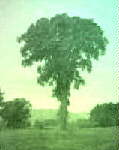 At the middle of Park Square and for more than a century,
including the Revolutionary War period, an old elm tree witnessed Pittsfield
history. There are two markers in the square about the Old Elm.
At the middle of Park Square and for more than a century,
including the Revolutionary War period, an old elm tree witnessed Pittsfield
history. There are two markers in the square about the Old Elm.
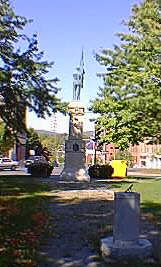 On the south side of park square at the entrance to Patrick’s
Pub is a marker indicating that a Pittsfield coffee house was used here as a
prison. At Bennington, American forces took 700 prisoners. No doubt, some of
them spent time at this coffee house prison.
On the south side of park square at the entrance to Patrick’s
Pub is a marker indicating that a Pittsfield coffee house was used here as a
prison. At Bennington, American forces took 700 prisoners. No doubt, some of
them spent time at this coffee house prison.
On the north side of Park Square is the First Church of Christ. The marker on the church indicates this congregation was active throughout the Revolution.
The northeast corner of Park Square was the site of Parson Allen’s home. There is a marker at the location.
Breakfast in Pittsfield — Just east of the Parson Allen marker is the Court Square Breakfast & Deli, a great place to get your Revolutionary Day started.
While you're having breakfast there, remember that not far from this very spot on the 2nd of May, 1775, Edward Mott and the Connecticut volunteers and James Easton, John Brown and the Berkshire volunteers had breakfast before their march to Bennington.
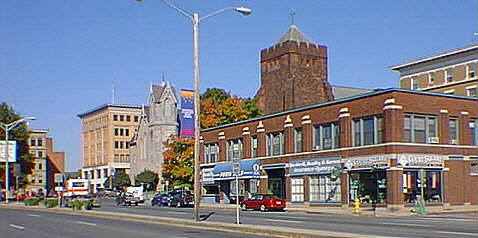
Lanesboro Marker.
 |
This tablet on the original steps of the marble from the Lanesboro Quarries marks the site of the first and second meeting houses of the First Church of Christ in Lanesboro organized March 28, 1764. "I have reared me a monument more lasting than bronze." |
